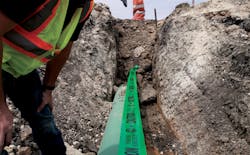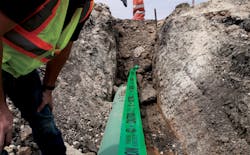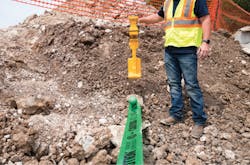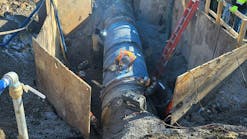MSD force main routes are marked with 3M EMS Marking Tape, which has regularly-spaced passive marker tabs.
St. Louis Metropolitan Sewer District Implements Successful Force Main Asset Management Program
By Denise Elliott
The Metropolitan St. Louis Sewer District (MSD), formed in 1954, is the fourth largest sewer district in the country, and manages wastewater and stormwater flow for the City of St. Louis, Mo., and most of St. Louis County. The district encompasses approximately 525 square miles, with a population of 1.3 million people. Average MSD sewage treatment flow is greater than 350 million gallons per day through the utility’s seven wastewater treatment facilities. The District Pump Station Division operates and maintains 276 pump stations and approximately 130 miles of force mains.
Several years ago, MSD adopted a Force Main Asset Management program partly as a response to the mandated requirements of a 2012 Consent Decree agreement between the District and the Environmental Protection Agency (EPA). The program’s goals are to implement a risk-based approach to managing force mains that maximizes the lifecycle of the District’s assets at the lowest possible overall cost, while concurrently minimizing the potential for negative environmental impact due to a pipe failure.
The Consent Decree agreement requires MSD to expend a specified revenue amount on sewer system improvements over a 23-year period. Rob Daly, MSD operations manager for the District Pump Station Division, is responsible for implementing the portions of the Consent Decree that are related to pump stations and force mains, which range in age from less than a year to more than 50 years old.
Although the District asset inventory of force mains is only about 3 percent of its overall pipe asset inventory, the typical cost to repair damaged force mains is substantially greater than it is for gravity mains. Additionally, the environmental impact of sanitary sewer overflow events is typically much greater for force main failures than for comparable gravity sewer failures.
Daly’s team conducted a root cause analysis of years of force main failure events and identified two primary force main failure modes. Corrosion of ductile iron pipe was found to be the predominant issue, accounting for approximately 60 percent of all pipe failures. Force main segments in the higher risk categories have been subjected to non-destructive testing as part of the MSD Asset Management program. This program is expected to, ultimately, significantly reduce the severity and frequency of force main emergency repairs, with their associated overflow events.
Another 30 percent of force main failures have been due to third-party strike damage by contractors, while the remaining ten percent of failures were one-off incidents — situational rather than systemic. A large component of the third-party strike failures have been greatly exacerbated by lack of information about actual pipe location in the field, resulting in poorer than desired One Call locate marking.
Daly’s initial kickoff of the Force Main Asset Management program began in 2011, right before the implementation of the 2012 Consent Decree. Daly’s Pump Station Division group resourced and executed a major staff training process for selected staff members on the principles and techniques of utility locating, utilizing 3M™ Utility Locating technology.
Once MSD staff were trained and equipped to effectively locate buried facilities, they executed a three-year program to locate, mark, survey, and remap the more than 400 individual force mains in their overall asset inventory with survey-quality measurements. Coordinates and facility details were recorded in the St. Louis utility’s GIS mapping system, with a significant improvement in the overall quality of pipe location information. This work was all performed by in-house staff resources and represented a major investment of time, energy, and dedication by those involved.
Next, based on expanded, and far more accurate, mapping information, as well as the team’s newly developed locating skills, they began a pipe-by-pipe process designed to validate and update force main asset information. This, in addition to the newly developed location information, resulted in a much higher level of accuracy for asset information in the District’s Computerized Maintenance Management System (CMMS).
The exact pipeline route is traced using a 3M Dynatel Locator to detect the buried marker tape.
In the 1990s, MSD began using 3M Electronic Marker System (EMS) Ball Markers for wastewater force main marking in order to precisely mark key buried elements and to record site-specific data. The ball marker is a permanent, self-contained and passive device that requires no power source. Markers are buried during construction or maintenance, and can be found and interrogated from the surface using a 3M Dynatel™ Locator.
Daly explained that markers were already in place in some force main segments, and proved very useful during the preliminary mapping phase since they provided precise starting points for pipe route mapping.
The Dynatel locators utilized by the District emit an RF signal, which prompts the passive ball marker to reflect back data that can include utility type and depth, the function of the marked component (such as valve, direction change or access point), and other details including a unique ID number, the owner of the buried element, date of ball placement and its depth below grade. Each ball marker’s pre-programmed serial number associates its exact marked point with utility records.
MSD finds RFID marking to be an accurate and reliable means for point location that is unaffected by soil conditions, the crowded utility environment, surface disruptions or temperature extremes. Unlike conventional passive markers, the RF marking system can differentiate between marked underground components, distinguish between utilities, and even between the facilities of multiple utilities having adjacent buried markers.
Several years ago, 3M introduced a new EMS path locating technology using plastic tape and rope versions with regularly spaced passive tags. MSD immediately adopted this EMS Path Marking Technology and began using it in new construction for all higher risk (i.e., typically larger diameter, longer) force mains, Daly said. In addition, MSD utilizes the new technology on any emergency repairs or rehab projects. The marking tape and rope use a common frequency, and are detectable at a depth of four feet.
According to Daly, marking rope is reserved for marking in directional drilling locations along force main pathways because of its ability to be pulled through drilled areas such as beneath driveways, while marking tape is used for open trench applications.
As with marker balls, marking tape and rope provide specific identification data and have an expected performance life far greater than traditional locator wire placed in the trench. Locator wire eventually corrodes and can also be interrupted in the event of excavator damage, while the viability of rope and tape marking, with regularly spaced transponders, does not depend on unbroken continuity for consistent traceability. Marker balls spaced at 100-foot intervals and marking tape and/or rope along the length of buried force mains are now used routinely to precisely define routes.
Recently, MSD established rate increases to fund the repair, rehabilitation, or replacement of aging force mains, and this ongoing activity has been greatly facilitated by the utility’s new and more accurate marking, locating and mapping resources. The new path-marking methods are improving the accuracy of One Call utility locators in the area, Daly said. This, in turn, is already helping reduce avoidable construction damage.
“When an outside contractor damages a force main, we own all the consequences of the resulting overflow,” said Daly, “and we are obliged to make emergency repairs as quickly and efficiently as possible.” MSD’s stated goal is to achieve dependable protection against such events through precise locating, mapping, analyzing and upgrading of infrastructure for preemptive maintenance and faster emergency repairs when required.
The St. Louis utility reported that as facility mapping continues to improve, damage costs have been reduced, with consequent financial and environmental benefits. “The elimination of a single damage incident on a high-risk force main saves MSD a minimum of $250,000, with even a low-risk force main repair costing in the range of $25,000, as well as the unacceptable impact of a sanitary sewer overflow,” Daly noted. Based on results to date, Daly expects catastrophic damage incidents on District force mains due to third-party strikes to be significantly reduced over the next three to five years as the program continues to mature.
“Electronic path marking and locating, precise mapping data, and proactive maintenance are making significant contributions to our progress in our overall Force Main Asset Management program, and helping ensure compliance with the 2012 Consent Decree,” Daly said. “With more precise records, we are experiencing fewer hits, and are able to complete repairs more quickly, with the result of reduced environmental impact and lower costs. The process of locating and analyzing force mains has moved us from reactive event locating to proactive path locating, and the investment has been well worth the cost.” WW
About the Author: Denise Elliott is a damage prevention specialist for 3M with a master’s in business. As an active damage prevention advocate, she works with various damage prevention organizations and teams including many 811 One Call Centers and is a frequent speaker at industry organizational conferences/seminars on damage prevention and safe digging practices.





